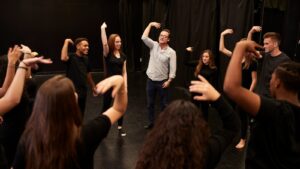Nursery Rhymes for Adults
Sometimes throughout the English speaking world, and even beyond, we frequently read aloud time-honored nursery rhymes and stories to our children. Hearing traditional tales brings great enjoyment to boys and girls all over the world. Of course, almost everyone knows that, but not too many persons have ever considered that those treasured sayings can become teaching aids.
How, someone might ask? For two important areas of English teaching, that’s how: (1) helping non-English speakers learn the language, and (2) vocabulary development among older English-speaking children and adults in their lives.
The following matching exercise demonstrates one way of capitalizing on child and adult memories of those sayings and stories to build such language usage skills. (And have lots of fun in the process.)
Match the rhyme or story named in Column One with the words or phrase that help identify the story from Column Two.
1. ___ Three Little Pigs A. accessed small water body
2. ___ Humpty Dumpty B. procure obese porcine
3. ___ Little Engine C. observe large visual organs
4. ___ Itsy Bitsy Spider D. arachnophobia
5. ___ Peter Rabbit E. nightcrawler quest
6. ___ Yankee Doodle F. residential construction
7. ___ Little Red Riding Hood G. descended rain gutter
8. ___ Baa Baa Black Sheep H. confident of performance
9. ___ Little Miss Muffet I. MacGregor’s protagonist
10. ___ Ducky Duddle J. descent from status
11. ___ Robin Red Breast K. rode to urban location
12. ___ Hey Diddle Diddle L. yarn making material available
13. ___ To Market, To Market M. musical feline
ANSWERS: 1=F, 2=J, 3=H, 4=G, 5=I, 6=K, 7=C, 8=L, 9=D,
10=A, 11=E, 12-M, 13=B.
Many nursery rhymes, folktales and children’s stories exist in different language versions. The causes of this are often based on migration. Newly arriving persons in a new country bring with them their legends, where those traditional, time-honored tomes merged with those of the new nation. The United Kingdom has been a good example of this phenomenon, followed later in history by Australia and the United States.
Linguistics cannot be divorced from history and geography. The original Britishers, descendants of prehistoric Doggers and Picts, were joined over the centuries in succession by Celts, Romans, Saxons, Flemish, Vikings and Normans. This process is on-going, as today refugees from strife in the Middle East take their turn, becoming the newest English men and women.
The implications of this on-going process are that the language, both in terms of spoken vocabulary, grammatical rules, literature and everyday usage patterns follow along. A good example of this phenomenon is exemplified in the nursery rhymes and children’s stories; they undergo adaptation and live on too. Of course, new ones are created to join the vast body of literature that the newcomers brought with them and translated. An example of this is the nursery rhymes spawned by British political goings-on. For example, the original Humpty Dumpty was a cannon used by Royalist forces in the English Civil War, not an egg.
Spelling and pronunciation changes over the centuries also provide great opportunities for language education. For instance, as Roman control collapsed in Britain, Saxons, ethnically German, migrated into England; a Germanic tongue quickly replaced a Latin one. The German word for dog, hund, also meaning to hunt, soon became the English surname Hunt.
Later, as William the Conqueror brought his French speaking followers with him; they all used the second personal French language pronoun vous. It’s easy to see how the English pronoun you came into existence. Why are these and myriad other linguistic curiosities important? Because today’s immigrants are not basically different from those Saxons and Normans; everybody has a language, subject to change or modification as the situation warrants.
The implication for teaching English (or any other language, for that matter) is that language is an on-going saga in anyone’s personal life. It is an important dimension of existence, but an ever-changing, flexible one. The nursery rhymes and children’s stories help to demonstrate this; almost all have a counterpart in another tongue. A good classroom activity to demonstrate this is to trace the male English name “John” across Western languages:
Hans (German), Jean (French), Juan (Spanish), Ivan (Russian),
Sean (Gaelic), Giovanni (Italian), Jan (Dutch). If this proves inadequate, move on to translatable expressions meaning essentially the same thing; careful, this can easily become X-rated!
A logical next step in applying nursery rhymes, etc. across multi-linguistic barriers lie in English vocabulary building. Find-synonyms have great potential for learning meanings, spelling and pronunciation. For example, did Goldilocks eat the Three
Bears’ porridge? If so, define porridge.–Is it the same thing as soup? If so, then pronounce it correctly. Then spell it correctly. Give another synonym, for instance, is porridge the same this as gruel? Why or why not?
When a language is viewed as a transitory, yet important dimension of human existence, it emerges as the major vehicle of cultural transmission. The innumerable little stories, terms and usage patterns folks have created to pass on civilization become factors in this process. People have been doing this since the since the beginning of human existence and don’t even realize it.







